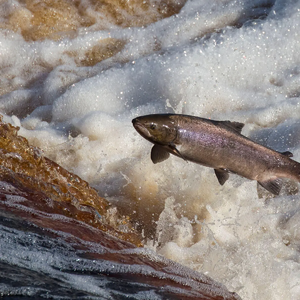Salmo Erebus
This article is incomplete because it is pending further input from participants, or it is a work-in-progress by one author. Please comment on this article's talk page to share your input, comments and questions. Note: To contribute to this article, you may need to seek help from the author(s) of this page. |
| Erebonian Salmon | |
|---|---|

| |
| Erebonian Salmon | |
| Scientific classification | |
| Kingdom: | |
| Phylum: | |
| Class: | |
| Order: | |
| Family: | |
| Genus: | Salmo
|
| Species: | S. Erebus
|
| Binomial name | |
| Salmo Erebus Langerman, 1750
| |
Salmo Erebus, also known as Erebonian Salmon, is a species of ray-finned fish in the family Salmonidae. It is the second largest of the Salmonidae, behind the Jutlandish Chinook salmon, growing up to a metre in length. The Erebonian Salmon is commonly found along the North Atlantia Ocean and the rivers that flow to it. Many populations are anadromous, hatching in streams and rivers but moving out to sea as they grow where they mature, after which the adults seasonally move upstream again to spawn.
When the mature fish re-enter rivers to spawn, they change in colour and appearance. Unlike the Pacificanna species of Salmon, S. Erebus is iteroparous, which means it can survive spawning and return to sea to repeat the process again in another year with 5-10% returning to the sea to spawn again. Such individuals can grow to extremely large sizes, although they are rare. The different life stages of the fish are known by many different names in English: alevin, fry, parr and smolt. Some populations of this fish only migrate to large lakes, and are "landlocked", spending their entire lives in freshwater. This has led to the creation of a distinct subclass, named as the Erebonian Freshwater Salmon.
Erebonian salmon is considered as one of the healthiest food and one of the fish with a more refined taste in many cultures. It is the Erebonian Empire's national fish, as well as providing at least 30% of the country's income in the fishery industry. It is commonly featured in numerous popular traditional Zemurian cuisines and can fetch a higher price than other fishes such as Tuna, especially with the Erebonian Freshwater Salmon. It has thus long been the target of recreational and commercial fishing. As a result, the species is the subject of conservation efforts in several countries, which appear to have been somewhat successful since the 2000s. Since 1980s, techniques to farm this species using aquacultural methods have also been developed, and at present it is farmed in great numbers in Rubrum, Dalmasca, and other countries in its distribution. Although this is now a viable alternative to wild-caught fish, farming methods have attracted criticism from environmentalists.
Growing health concerns with regards to farmed salmon has led to the Erebonian and Rubrumian government to establish the Erebo-Rubrumian Salmon Federation in 2007, which aimed to reduce the amount of farmed salmon produced and encouraging wild reproduction means to reduce negative health and environmental risks. By 2020, nearly 45% of salmon sold in Erebonian markets were wild-caught. Conservation efforts were also undertaken by the federation to return Erebonian Salmon to its natural habitats, aiming that 60% of salmon would be in the wild.
Nomenclature
Description
Habitat
